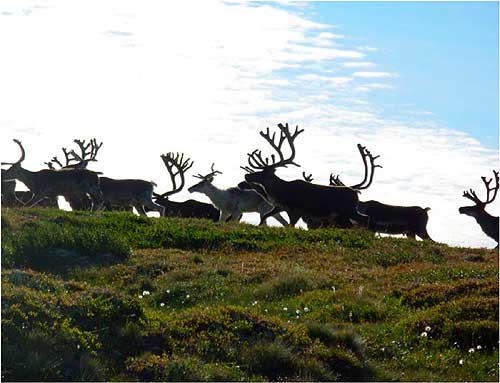 Alaska Science
Bitter weather may have wiped
out reindeer
Alaska Science
Bitter weather may have wiped
out reindeer
By NED ROZELL
January 08, 2010
Friday
Six thousand reindeer once lived on a remote island in the Bering
Sea that was briefly their paradise. In what has become a classic
story of wildlife boom and bust, no reindeer live on St. Matthew
Island now. Three scientists just looked back at the St. Matthew's
reindeer herd and found that an extreme winter probably pushed
the stressed animals to their deaths.
The story began in August 1944, when the U.S. Coast Guard corralled
29 Nunivak Island reindeer on a barge and floated the animals
north to St. Matthew Island, more than 200 miles away and one
of the most remote places in Alaska. Coast Guard officials had
earlier in the year placed a radio navigational system on the
island, along with 19 men. The reindeer were intended as a roaming
food source should the men be cut off from supply shipments.
 Reindeer of St. Matthew
Island in the 1960s, before they disappeared.
Reindeer of St. Matthew
Island in the 1960s, before they disappeared.
The men never shot a single reindeer; the Allies were winning
the war, and the Coast Guard pulled its men from the island.
They left the reindeer.
This was a fine situation for the animals at first-their only
predators had disappeared, leaving them on a 32-mile long, four-mile
wide island rich with their favorite food, lichen.
Biologist Dave Klein first stepped on the island in 1957, 13
years after the Coast Guard had abandoned it. Klein, 82, now
a professor emeritus for the University of Alaska Fairbanks'
Institute of Arctic Biology, hiked the length of the island with
field assistant Jim Whisenhant in 1957. They noted that the herd
of 29 reindeer had increased to more than 1,300 animals.
Klein returned to the hard-to-reach island six years later. He
could hardly believe how many reindeer were there.
"We counted 6,000 of them," Klein said in a 2003 interview.
"They were really hammering the lichens."
The scene, with its 47 reindeer per square mile, foreshadowed
a crash ahead. That's what Klein found on a return to the island
in the summer of 1966. In the three years since his last visit,
the herd of 6,000 had shrunk to 42, a number that included only
one male that had abnormal antlers and probably was unable to
reproduce. Reindeer skeletons littered the tundra.
The herd had busted. During the next decade or so, all the reindeer
of St. Matthew Island died off; the largest mammal there now
is the arctic fox.
Klein found the story so intriguing that he mentioned it often
over the years in conversations about the Bering Sea. Recently,
he shared his thoughts with two climatologists; he suspected
that an extreme winter might have forced the stressed population
of reindeer to the brink. Soon, Martha Shulski and John Walsh
were helping Klein reconstruct the events of the extraordinarily
harsh winter of 1963 to 1964.
Shulski, a former Alaska climatologist who is now director of
the High Plains Regional Climate Center at the University of
Nebraska, and Walsh, chief scientist at UAF's International Arctic
Research Center, dug up weather records from the nearest official
weather station to St. Matthew. That station is located 200 miles
south on St. Paul Island. The scientists pored over a reanalysis
of area weather variables provided by the National Centers for
Environmental Prediction.
They found - and described in an article in the November/December
2009 issue of the magazine Weatherwise -that the winter of 1963-1964
was one of the most extreme on record in the northern Bering
Sea.
During February and March 1964, the reindeer experienced almost
constant windstorms, the nastiest of which featured an atmospheric
pressure typical of a Category 3 hurricane. Blasting northerly
winds combined with below-zero air temperatures to create wind
chills below minus 40 degrees Fahrenheit for a week straight
in early February, and a low wind chill reading of minus 71.5
degrees Fahrenheit on March 13, 1964, when the air temperature
was minus 34 degrees and the wind blew 30 mph.
Perhaps even more damaging to the reindeer were record amounts
of snow. St. Paul, Alaska received 140 inches of snow during
the 1963-1964 season.
"The higher snow depths and hard crusts on the snowpack
. . . meant the reindeer were virtually prevented from obtaining
any of their already depleted food resources," the scientists
wrote in Weatherwise. They concluded that only 42 reindeer survived
the storm. When Klein examined the skeletal remains during his
1966 visit, he saw that the bones of fetal reindeer nestled within
the bones of their mothers revealed that "most of the pregnant
females had died about the time of the storms or shortly thereafter."
The reconstruction of extreme weather events has given Klein
some closure on a mystery he had pondered since he visited the
island in the late 1960s, and all three scientists now appreciate
the vulnerability of some groups of animals.
"In isolated or fractured environments, wildlife populations
can be extinguished by severe weather events," John Walsh
said in a presentation about the St. Matthew reindeer he gave
at the 2009 Fall Meeting of the American Geophysical Union in
San Francisco.
This column is provided
as a public service by the Geophysical
Institute,
University of Alaska Fairbanks, in cooperation with the UAF
research community.
Ned Rozell [nrozell@gi.alaska.edu]
is a science writer at the institute.
E-mail your news &
photos to editor@sitnews.us
Publish A Letter in SitNews Read Letters/Opinions
Contact the Editor
SitNews
©2010
Stories In The News
Ketchikan, Alaska
|



